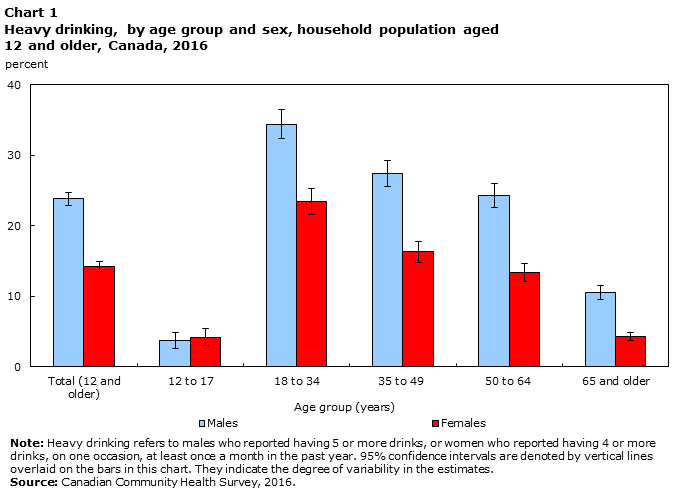Health Fact Sheets
Heavy drinking, 2016
Archived Content
Information identified as archived is provided for reference, research or recordkeeping purposes. It is not subject to the Government of Canada Web Standards and has not been altered or updated since it was archived. Please "contact us" to request a format other than those available.
In 2016, 19.0% of Canadians aged 12 and older (roughly 5.8 million people) reported alcohol consumption that classified them as heavy drinkers.Note 1 The proportion aged 12 and older who reported alcohol consumption that classified them as heavy drinkers remained stable between 2015 and 2016.Note 2
Overall, males were more likely (23.8%) to report heavy drinking than females (14.2%) in 2016.
The highest proportion of heavy drinking for both sexes was among those aged 18 to 34. In this age group, 34.4% of males and 23.4% of females were heavy drinkers (Chart 1).

Data table for Chart 1
| Age group (years) | Percent | Confidence Interval | |
|---|---|---|---|
| Lower 95% limit | Upper 95% limit | ||
| Males | |||
| Total (12 and older) | 23.8 | 23.0 | 24.7 |
| 12 to 17 | 3.7 | 2.6 | 4.8 |
| 18 to 34 | 34.4 | 32.5 | 36.4 |
| 35 to 49 | 27.4 | 25.7 | 29.2 |
| 50 to 64 | 24.3 | 22.7 | 26.0 |
| 65 and older | 10.5 | 9.4 | 11.5 |
| Females | |||
| Total (12 and older) | 14.2 | 13.6 | 14.9 |
| 12 to 17 | 4.2 | 3.1 | 5.4 |
| 18 to 34 | 23.4 | 21.7 | 25.2 |
| 35 to 49 | 16.3 | 14.8 | 17.8 |
| 50 to 64 | 13.4 | 12.1 | 14.7 |
| 65 and older | 4.3 | 3.7 | 4.9 |
|
Note: Heavy drinking refers to males who reported having 5 or more drinks, or women who reported having 4 or more drinks, on one occasion, at least once a month in the past year. 95% confidence intervals are denoted by vertical lines overlaid on the bars in this chart. They indicate the degree of variability in the estimates. Source: Canadian Community Health Survey, 2016. |
|||
Despite the fact it is illegal to sell alcohol to anyone under 18 in Canada,Note 3Note 4 27.9% of Canadian youth aged 12 to 17 reported consuming an alcoholic beverage in the previous 12 months. Among those who did drink, 41.8% of them did so at least once a month. Overall 4.0% of youth were classified as heavy drinkers.
The 2016 Canadian Community Health Survey included questions on alcohol use during the last week. According to Canada”s Low-Risk Alcohol Drinking Guidelines, 16.6% of Canadians are consuming alcohol at a level that puts their long term health at risk.Note 5
Start of text box
About heavy drinking
Excessive alcohol consumption can have serious health and social consequences, especially when combined with other behaviours such as driving while intoxicated. For males, heavy drinking refers to having consumed five or more drinks, per occasion, at least once a month during the past year. For females, heavy drinking refers to having consumed four or more drinks, per occasion, at least once a month during the past year.
According to Canada”s Low-Risk Alcohol Drinking Guidelines, long term risks for alcohol consumption are liver disease and certain cancers. Males are classified at risk if they had more than 15 drinks in the week of reporting or at least one day with 4 or more drinks. Females are classified at risk if they had more than 10 drinks in the week of reporting or at least one day with 3 or more drinks.
For analysis of heavy drinking with other healthy behaviours see the “Healthy Behaviours Fact Sheet”.
End of text box
References
Hindmarch I., J. Bhatti, G. Starmer, D. Mascord, J. Kerr, and N. Sherwood. 1992. The effects of alcohol on the cognitive function of males and females and on skills relating to car driving. Human Psychopharmacology: Clinical & Experimental. Vol. 7, no. 2.
Hotton, T., and D. Haans. 2004. “Alcohol and drug use in early adolescence”. Health Reports. Statistics Canada Catalogue no. 82-003. Vol. 15, no. 3. (accessed January 11, 2017)
Pérez, C. 2005. “Passengers of intoxicated drivers”. Health Reports. Statistics Canada Catalogue no. 82-003. Vol. 16, no. 2. (accessed January 11, 2017)
Public Health Agency of Canada (PHAC). 2015. The Chief Public Health Officer”s Report on the State of Public Health in Canada 2015: Alcohol Consumption in Canada. Canada. (Accessed August 1st, 2017)
Tjepkema, M. 2004. “Alcohol and illicit drug dependence”. Health Reports. Statistics Canada Catalogue no. 82-003. Vol. 15 (Supplement). (accessed January 11, 2017)
Wilkins, K. 2002. “Moderate alcohol consumption and heart disease”. Health Reports. Statistics Canada Catalogue no. 82-003. Vol. 14, no. 1. (accessed January 11, 2017)
Data
Additional data from the Canadian Community Health Survey are available from CANSIM table 105–0508.
Notes
- Date modified:

